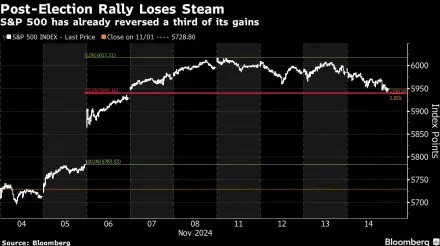Railroad stocks tumbled Thursday in response to the Trump administration’s Wednesday announcement of widespread tariffs on U.S. trading partners.
It was an indication that investors believe the tariffs will raise prices and have a negative impact on consumer spending, which in turn will reduce demand for the raw materials and finished products that railroads carry.
As U.S. stock markets opened on Thursday, the S&P 500 was down nearly 4%. CSX (NASDAQ: CSX) and Union Pacific (NASDAQ: UNP) stock prices slumped by 4%, while Norfolk Southern (NYSE: NSC) was down nearly 5%.
The Canadian railways fared better, perhaps because Canada and Mexico – which were early tariff targets – were exempt from the reciprocal tariffs announced at the White House on Wednesday. Canadian National (NYSE: CNI) stock was up slightly in morning trading, while Canadian Pacific Kansas City (NYSE: CP ) was down by 0.7%.
“There is a sense of relief that Canada and Mexico were spared from additional tariffs. As the market starts to worry about the impact of tariffs on economic growth, it may also become relevant that, for Canadian investors, CN and CPKC are viewed as two of a limited number of ‘blue chip’ Canadian industrial stocks,” said Cherilyn Radbourne, a Toronto-based analyst for TD Securities.
For the U.S. railroads, the reciprocal tariffs on China, the European Union, Japan and other Asian nations were higher than anticipated.
“Ultimately, Trump’s tariff announcements were less onerous than feared for North American trade partners Canada and Mexico and worse than feared for China and other U.S. trade partners in Asia,” said Bascome Majors, an analyst at Susquehanna Financial Group. “This dynamic is playing out today in rail stocks with Canadian rails CP and CN outperforming and in broader transportation stocks with international trade levered businesses like Expeditors, FedEx, and UPS underperforming.”
Given the often fluid nature of President Donald Trump’s tariff plans this year, independent rail analyst Anthony B. Hatch wondered how the situation might change in the coming weeks and months.
“It appears that Canada and Mexico were spared,” Hatch says. “But spared for how long?”
The United States-Mexico-Canada Agreement trade deal signed during the first Trump administration comes up for renegotiation next year, Hatch notes. And the 25% tariffs imposed on imports of steel and aluminum from Canada and Mexico remain in force.
Yet Hatch says the steep reciprocal tariffs on imports from other countries – like the 24% levy on Japanese products – may help make Canadian and Mexican products more competitive in the U.S.
Stellantis, however, announced Thursday that due to tariffs it would temporarily suspend production of Chrysler minivans at its assembly plant in Windsor, Ontario, and the Jeep Compass at its plant in Toluca, Mexico. It also was laying off employees at plants that make parts for the minivans and Jeep SUV.
Hatch contends that more than half of rail traffic is trade-related in one way or another. It won’t be clear what the tariff impact on rail traffic might be until railroad shippers have time to analyze how tariffs might affect their businesses, Hatch says.
Under the plans outlined Wednesday, the U.S. will impose a 10% tariff on all imports and significantly higher rates for some nations that are deemed bad trade actors. Trump called the plan “Liberation Day” and said the tariffs would reduce trade imbalances and promote U.S. manufacturing.
“Jobs and factories will come roaring back into our country, and you see it happening already,” Trump said. Companies seeking to avoid tariffs, he adds, should build their products in the U.S.
The post New US tariffs hit railroad stocks in early trading appeared first on FreightWaves .





